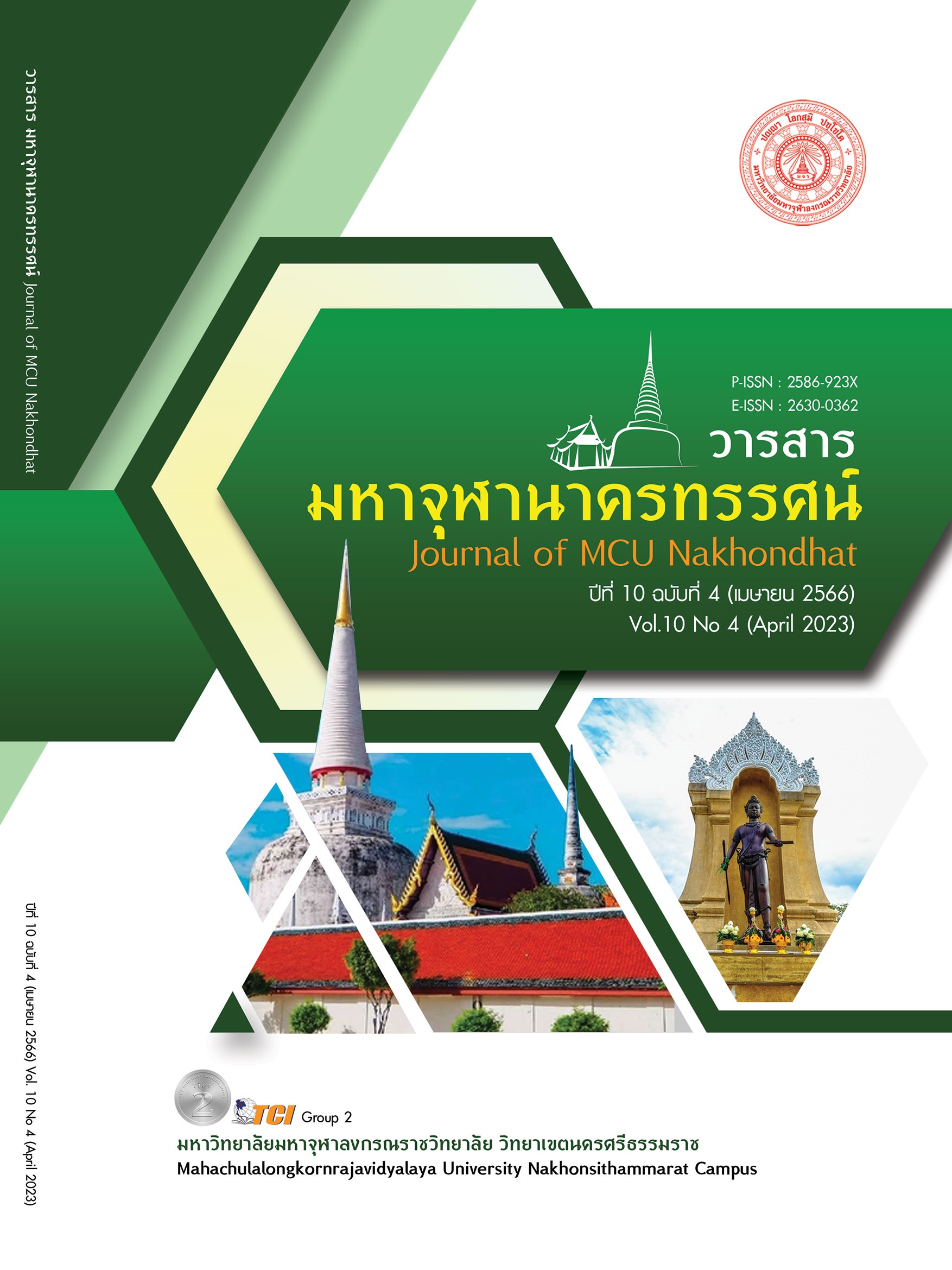THE INFLUENCES OF CORPORATE SOCIAL RESPONSIBILITY COMMUNICATION VIA ONLINE MEDIA ON TRUST, ADVOCACY, AND BRAND EQUITY IN OIL BUSINESS AMONG THAI CONSUMERS
Main Article Content
Abstract
The objectives of this research article were to: 1. corporate social responsibility communication via online media in various fields including 1) Trust 2) Advocacy 3) Brand Equity and 2) the influence of corporate social responsibility communication via online media in various fields including 1) Trust 2) Advocacy 3) Brand Equity is quantitative research using the survey research process the sample is Thai consumers. Multi-Stage Random Sampling was selected of 400 people. Methods used in the research were: online questionnaire. The statistics used for the analysis were frequency, percentage, mean and standard deviation, t-test, One-Way ANOVA and Multiple Regression Analysis (MRA) with a statistical significance level of 0.05. The research findings indicated that 1. Exposure to Corporate Social Responsibility Communication via Facebook the most, most of them are exposure to communicating corporate social responsibility through Facebook. Followed by Website, YouTube, Line, and Instagram. 2. The Influences of Corporate Social Responsibility Communication Via Online Media in Oil Business Among Thai Consumers. In various fields including 1) Trust, there are 3 channels, arranged as follows: (1) Facebook (2) YouTube and (3) Instagram 2) Advocacy, there are 3 channels, arranged as follows: (1) Facebook (2) Website and (3) Instagram 3) Brand Equity, there are 5 channels, arranged as follows: (1) Website (2) Facebook (3) YouTube (4) Line and (5) Instagram. The results of this research the results of this research can be used as a guideline for oil business conductors in choosing online media effectively. Moreover, it is useful for those who are interested in studying research related to the use of online media in communicating social responsibility.
Article Details

This work is licensed under a Creative Commons Attribution-NonCommercial-NoDerivatives 4.0 International License.
References
กรมธุรกิจพลังงาน. (2564). ข่าวพลังงานประจำวัน ธุรกิจน้ำมันภายในประเทศในประเทศไทย. เรียกใช้เมื่อ 30 ตุลาคม 2565 จาก https://www.energynewscenter.com/
ชนมาศ ชัยศรี. (2563). การศึกษาความรับผิดชอบต่อสังคมขององค์กรที่มีอิทธิพลต่อคุณค่าตราสินค้าและกระบวนการตัดสินใจซื้อของกลุ่มลูกค้าองค์กรในประเทศไทย. วารสารเกษตรศาสตร์ธุรกิจประยุกต์, 16(24), 1-28.
นธกฤต วันต๊ะเมล์. (2555). การสื่อสารการตลาด. กรุงเทพมหานคร: มหาวิทยาลัยเกษตรศาสตร์.
น้ำทิพย์ วิภาวิน. (2558). Network in a Networked Society. วารสารวิจัยสมาคมห้องสมุดแห่งประเทศไทยฯ,, 8(2), 119-127.
วรมน บุญศาสตร์. (2559). องค์กรรับผิดชอบต่อสังคม : ทัศนคติ และการตอบสนองด้านคุณภาพการบริการ ภาพลักษณ์องค์กร ความไว้วางใจ ความตั้งใจซื้อและการบอกต่อ ของกลุ่มผู้บริโภคเจนเนอเรชั่น ซี. วารสารการสื่อสารและการจัดการ นิด้า, 2(2), 1-18.
วิภาดา วีระสัมฤทธิ์. (2553). ความรับผิดชอบต่อสังคมขององค์กร (CSR) ที่มีผลต่อความจงรักภักดีของลูกค้าของบริษัท แอดวานซ์ อินโฟร์ เซอร์วิส จำกัด (มหาชน). เรียกใช้เมื่อ 3 พฤศจิกายน 2565 จาก http://thesis.swu.ac.th/swuthesis/Man /Phitchaya_L.pdf
สุรพงษ์ คงสัตย์ ธีรชาติ ธรรมวงค์. (2551). การหาค่าความเที่ยงตรงของแบบสอบถาม (IOC). กรุงเทพมหานคร: มหาวิทยาลัยมหาจุฬาลงกรณราชวิทยาลัย.
Aaker, D. A. (1991). Managing brand equity: Capitalizing on the value of a brand name. New York: Free Press.
Atkin, C. K. (1973). New Model for Mass Communication Research. New York: The Free Press.
Badrinarayanan, V., & Laverie, D. A. (2013). The Role of Manufaturers’ Salespeople in Inducing Brand Advocacy by Retail Sales Associctes. Journal of Marketing Theory and Practice. Retrieved Octcter 30, 2022, from https://doi.org/10.2753/MTP1069-66792101041069-6679210104
Berry, L. L., Zeithaml, V. A., & Parasuman, A. (1990). Five imperatives for improving service quality. MIT Sloan Management Review, 31(4), 29.
Bonsu, S. K. (2018). Corporate Social Responsibility Implementation Framework. Walden University: ProQuest Dissertations Publishing.
Bourdeau, L. B. (2005). A New Examination of Service Loyalty: Identification of the Antecedents and Outcomes of Additional Loyalty Framework. In Dissertation, Ph.D. (Business Administration). Florida University. Photocopied.
Cronbach, L. (1990). Essentials of Psychological Testing. (5 th ed). New York: Harper Collins.
Keller, K. L., Parameswaran, M. G., & Jacob, I. (2011). Strategic Brand Management: Building, Measuring, and Managing Brand Equity. Pearson. Retrieved November 3, 2022, from https://books.google.co.th/books?id=cofhZbwwFuYC
Kotler, P., & Keller, K. L. (2016). A framework for marketing management. (6th Ed.). England: Pearson Education Limited.
Mishra, A. (1996). Organizational Responses to Crisis, The Centrality of Trust. Open Journal of Social Sciences, 3(3), 261-281.
Morgan, R., & Hunt, S. (1994). The Commitment-Trust Theory of Relationship Marketing. the journal of marketing, 58(3) 20-38.
Nyhan, R. C., & Marlowe, H. A. (1997). Development and Psychometric Properties of the Organizational Trust Inventory. Retrieved November 3, 2022, from https://doi.org/10.1177/0193841x9702100505
Scott, J. T., & Maryman, J. (2016). Using social media as a tool to complement advocacy efforts. Global Journal of Community Psycholgy Practive, 7(5), 1-22.
Standard. (2022). ISO 26000 Social responsibility. Retrieved November 3, 2022, from https://www.iso.org/iso-26000-social-responsibility.html
Statista. (2565). Social media in Thailand. Retrieved November 3, 2022, from https://www.statista.com/topics/8194/social-media-in-thailand/#topicOverview


